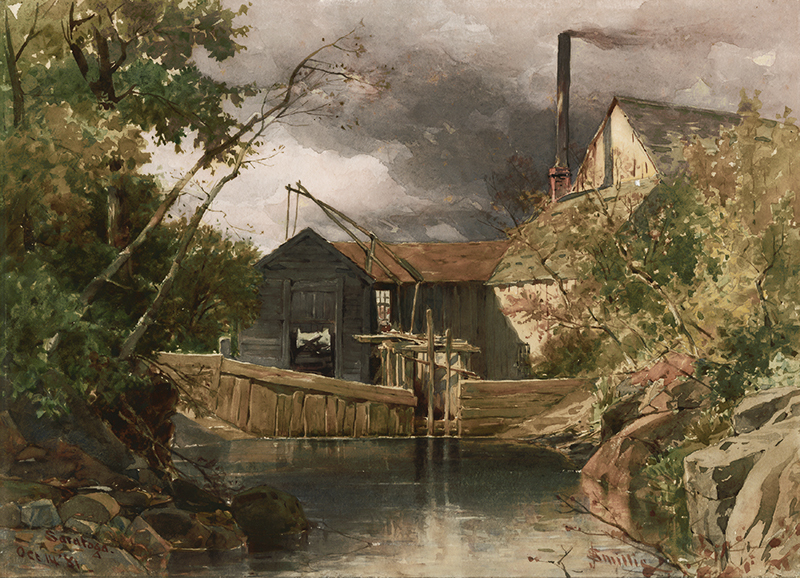
19th, 20th & 21st Century Fine Prints
707-546-7352 · fax 707-546-7924 · web: www.annexgalleries.com · email: artannex@aol.com
Study of Old Saw Mill near Saratoga, N.Y. by James David Smillie

Study of Old Saw Mill near Saratoga, N.Y.
James David Smillie
Study of Old Saw Mill near Saratoga, N.Y.
James David Smillie
1833 - 1909 (biography)Logging in the Adirondacks began as small operations at the beginning of the nineteenth century and quickly ramped up within twenty years. The vast forests must have seemed inexhaustible and the rivers provided an easy means to float logs downstream to various mills. Smillie seems to been drawn to the picturesqueness of old buildings built over or near water.
This theme is repeated in his watercolors Saratoga from 1881 and Rear of No. 1, Portland Pier, Portland, Maine from 1880. With Study of Old Saw Mill Near Saratoga, Smillie captured an old but still functioning saw mill belching black smoke from the chimney. Despite the tranquil scene, the saw mill is a symbol of the vast destruction done by the logging industry to the land, forests, and waterways. The mill situated over placid waters and surrounded by an abundance of trees is far from barren landscape clear cut by the loggers.
James David Smillie was born in New York City on January 16, 1833, the eldest son of Katharine van Valkenberg and James S. Smillie. His father, a noted engraver, had a major influence on nineteenth century American engraving and etching and is probably best known for his banknote engraving with Rawden, Wright and Hatch, and for his engravings after Thomas Cole's painting series, "Voyage of Life".
James D. Smillie studied at the Poughkeepsie Collegiate School and later at the University of New York. It has also been noted that he studied at the National Academy of Design in New York. Young James learned the art of engraving from his father and when he was eight years old produced his first etching on copper, a visiting card plate. In January 1846, he tried his first attempt at composition with a watercolor of the fall of Satan after Milton’s poem, Paradise Lost.
After two years traveling in Europe, James D. Smillie returned to New York and took up landscape painting. His younger brother George, also an artist, had a studio in New York City and James rented a room in the same building located at 212 Fifth Avenue. He sought inspiration for his imagery in rural settings in New York State, including the Catskills and the Hudson Valley, eastern Pennsylvania, and western Massachusetts.
James D. Smillie exhibited in the spring exhibition of the National Academy of Design in 1864, and also exhibited at the Brooklyn Art Association, the Boston Athenaeum, the Artists Fund Society, the Metropolitan Sanitary Fair (to raise funds for the Union wounded), and the Yonkers Sanitary Fair. He was made an associate member of the National Academy of Design in 1865 and taught at the Academy in 1868.
In 1866, he co-founded the American Society of Painters in Water Colors (the American Water-Color Society), later serving as its president from 1873 to 1879. He was elected a full Academician in the National Academy of Design in 1876, and served as treasurer between 1894 and 1898.
The Smillie brothers had difficultly supporting themselves due to the sparse sales of their paintings and found it necessary to live with their parents. A gift from an uncle allowed the brothers to travel across the country in June of 1871 and live for the better part of four months in Yosemite. During that summer, James drew, painted, and wrote about the majestic splendor of Yosemite. In 1872, Picturesque America was published by D. Appleton and Company of New York. James D. wrote The Yosemite section based upon his journal entries and illustrated it with engravings after his drawings and paintings.


